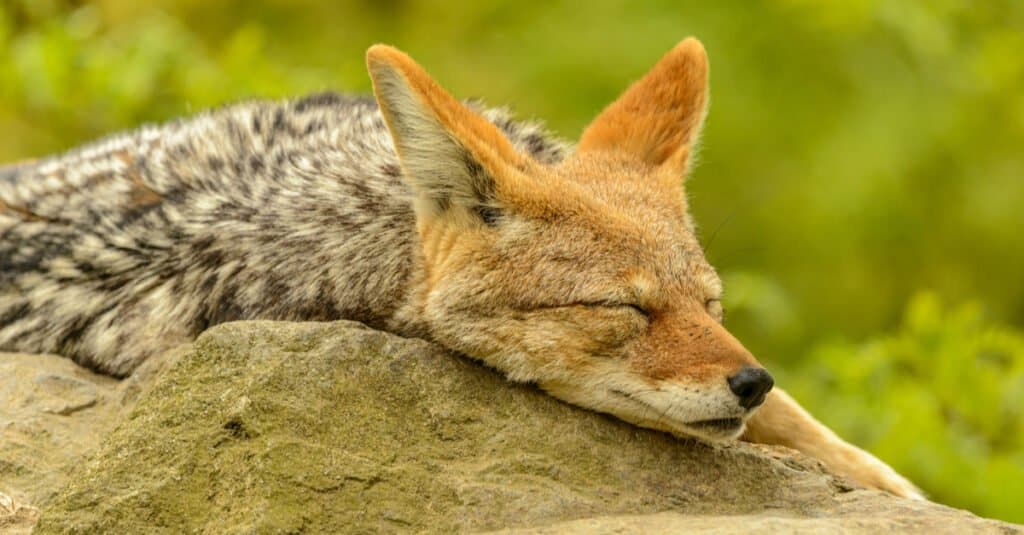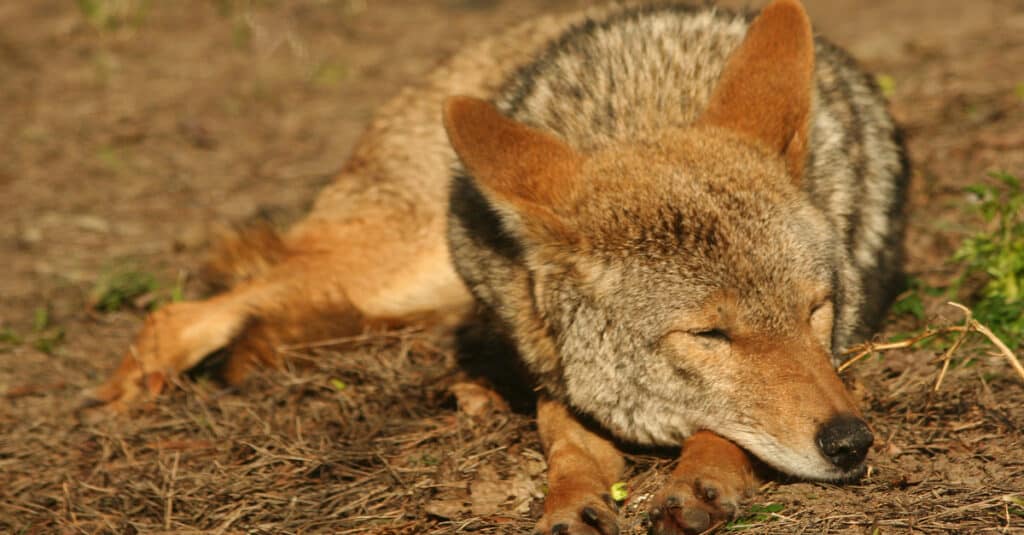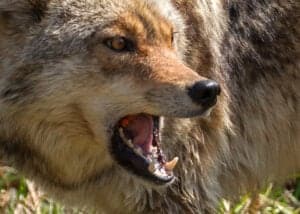There is a common misconception when it comes to coyotes and whether they are nocturnal. Coyotes are primarily diurnal mammals – they sleep at night and are mostly awake during daylight hours.
There are, however, some nocturnal coyotes. Whether a coyote is nocturnal or diurnal depends solely on its habitat. Coyotes are very adaptable to any environment they find themselves in.
Coyotes are native to North America and are known for their howling, medium size, and close resemblance to dogs. So how and where do coyotes sleep? In this article, we’ll be answering this question and giving you information on everything you need to know concerning their sleep pattern.
Where Do Coyotes Sleep?

Coyotes sleep in prairies, desert grounds, and dens in the wild.
©Petr Ganaj/Shutterstock.com
Coyotes sleep in prairies, desert grounds, and dens in the wild. They sleep in wooded foliage and shrubbery in urban areas. They like to avoid residential or commercial regions when looking for places to sleep in urban settlements. Instead of these places, you might find them sleeping or resting at a golf course or in parks.
There are various places where a coyote will sleep, as long as it is safe. A coyote’s den or resting place depends on its location. Coyotes are excellent diggers, and some of them dig into the ground to create a den for sleeping or resting. Below are some of the most common places a coyote will sleep:
In Tree Hollows
Coyotes will sleep in tree hollows in the wild, but these trees are usually ones that can provide adequate space for surveillance.
In Rock Outcrops
Coyotes will sleep in rock outcrops that offer a view of the same protective vegetation as a hollow tree. In the case of trespassers, they can see or detect any approaching danger easily.
In dens/ burrows of other animals
Coyotes also love sleeping in burrows dug by other animals. A bold coyote can find a burrow dug by a raccoon or badger, and it will move in to sleep. Burrows of badgers are perfect for coyotes with large packs.
In their den
Coyotes are excellent diggers, not as perfect as badgers, but they can dig into soft dirt to create a den for sleeping. They feel safer when they take the time to dig their dens/burrows.
Where Do Coyotes Sleep During The Winter?

In the winter, female coyotes and their pups seek warmth in dens.
©iStock.com/Gary Gray
Coyotes don’t hibernate in winter like other mammals; they can adapt to any extreme environment or weather, so winter is just like any other season for them. They possess ‘winter coats,’ with fur that keeps them safe from the winter breeze. Coyotes can sleep in the snow if they wish.
A female coyote with young will seek shelter in dens to sleep and provide warmth for her pups. Male coyotes, on the other hand, aren’t allowed in these dens, and they are not particular about finding a place to sleep in the winter. If they don’t find a place to sleep, they are usually found sleeping on the snow bed.
How Do Coyotes Sleep in Desert Regions?

The deserts provide open space for shelter for coyotes.
©Liga Alksne/Shutterstock.com
Coyotes love the desert terrain because it provides an abundant resource of food and open space for shelter. Sometimes, coyotes dig burrows or dens in the ground to provide a space for sleeping in the moist sand. Other times, they can decide to sleep in the den or burrows of other animals, especially the badger and raccoon. You can also find them sleeping under the shade of some small plants or on the patches of green grass.
When Do Coyotes Sleep?
The time a coyote sleeps depends on the environment it finds itself. For coyotes that live in or close to human settlements, they sleep during the day to avoid interacting with humans and come out at night to hunt for food.
Coyotes that live in regions with little or no human population tend to sleep at night and are active during the day. Nevertheless, all coyotes have varying sleeping schedules, so it is not predictable.
How Much Do Coyotes Sleep?
Coyotes don’t have a set number of hours that they spend sleeping. It can range from a few minutes to several hours. A coyote will only sleep for a long time if it is safely hidden in its den away from the threat of predators. Coyotes are closely related to dogs, so you might find a coyote sleeping for as long as 12 hours per day.
Sleeping Pattern Of a Coyote
The sleeping pattern of a coyote is very irregular, and they wake up frequently if they are disturbed by any noise. Coyotes possess remarkable hearing, making it difficult to sleep for long hours. During the day, if a coyote is woken up, it might be because of a disturbance in its surroundings.
What Sounds Do Coyotes Make While Sleeping?
Coyotes don’t make a lot of sounds when sleeping. Although occasionally, you might hear them groaning or whining while sleeping. This is a trait they share with their close relatives, dogs.
Do Coyotes Sleep in The Same Place For Long Periods Of Time?
Coyotes only make dens when they are having or have pups. They tend to stay in these dens long enough to nurture their pups before moving on. Coyotes are very mobile animals, and they move from place to place searching for food and also to protect their young from predators.
Coyotes build several dens on their mobile journey, so they don’t have to face the difficulty of making a new den to sleep. This allows them to move with their pups freely between dens without fear of predators.
Although coyotes can return to a particular den several times, some prefer to make new dens in the same territory to avoid the build-up of insects and droppings and also to prevent their food from getting contaminated.
Amazing Facts About Coyotes
- Coyotes can walk on their toes.
- They practice monogamy – one mate for life.
- Coyotes are very territorial, and they mark their territory with urine.
- The teeth of a coyote are 42 in number.
- Coyotes are closely related to dogs and can be differentiated by the way they hold their tail.
Conclusion
Now that you understand how and where coyotes sleep, including their sleeping pattern, it is easier for you to watch out for them, so they don’t encroach on your property. Note that if there is the availability of food and water in a particular area, coyotes will make use of that area as their territory and build dens.
The photo featured at the top of this post is © sumikophoto/Shutterstock.com
Thank you for reading! Have some feedback for us? Contact the AZ Animals editorial team.





